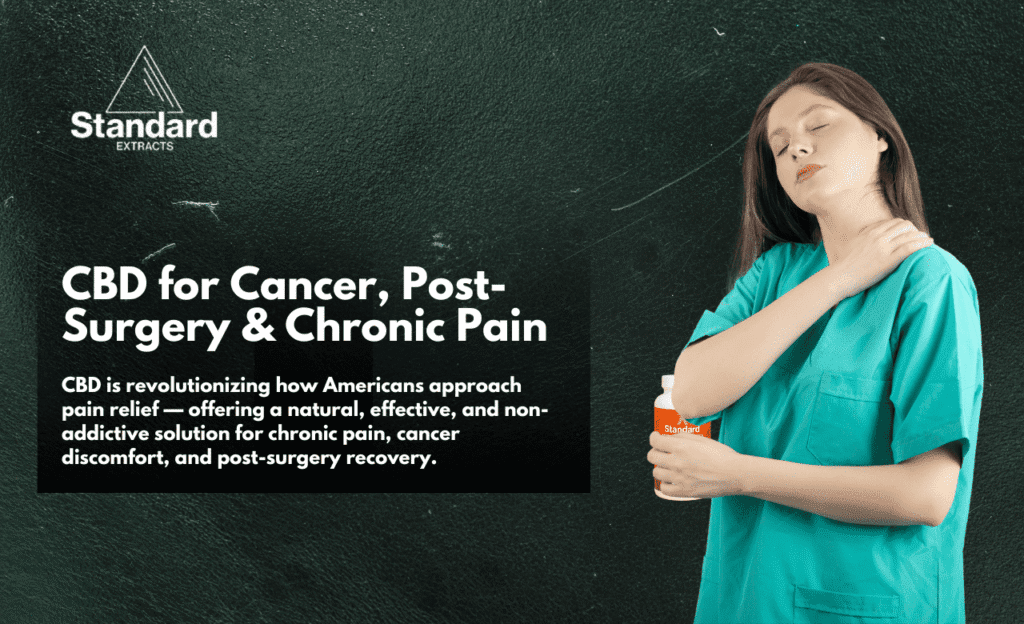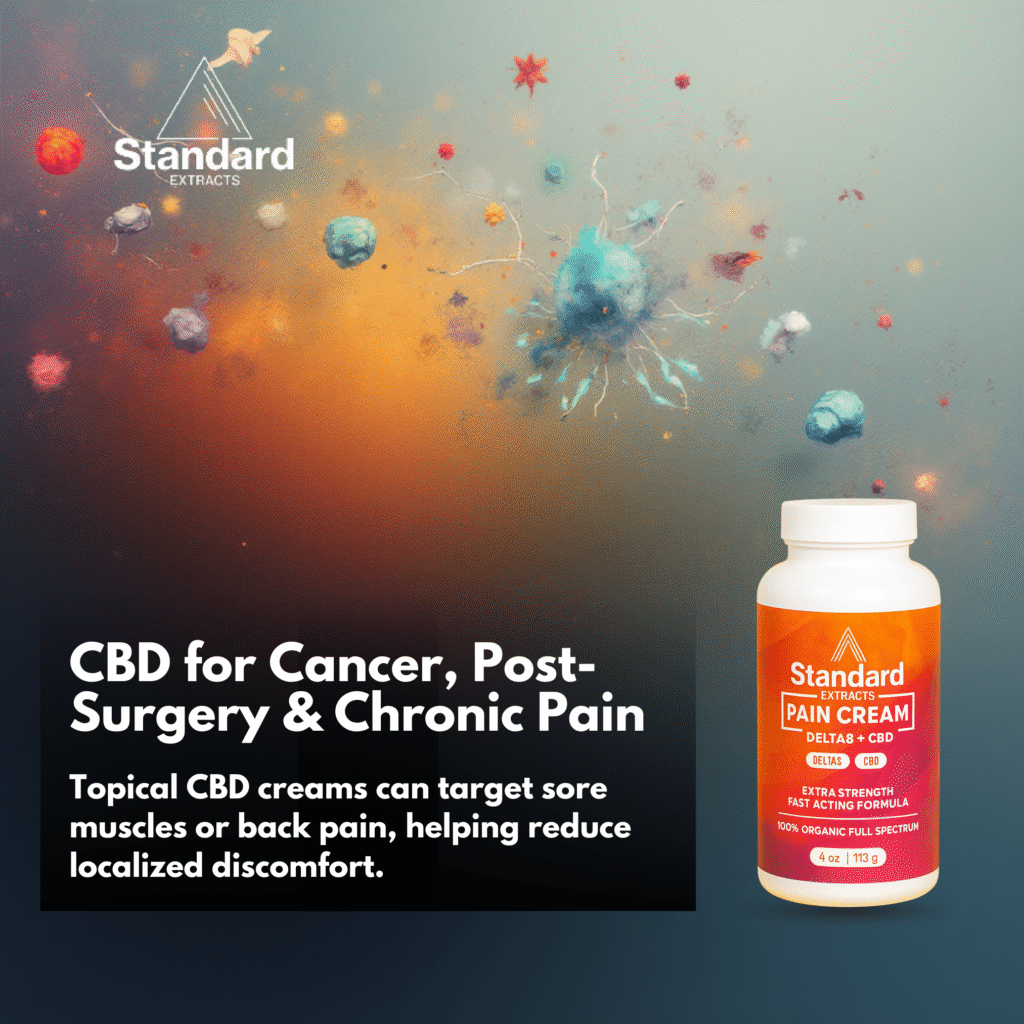CBD for Cancer, Post-Surgery & Chronic Pain Relief – Does It Really Work?
Pain is the body’s alarm system – but when it keeps ringing long after the injury heals, it becomes unbearable. From chronic pain that lasts years to cancer pain or post-surgical discomfort, Americans are turning to a natural option that’s changing how recovery feels:

Let’s dive into how CBD supports the body’s healing process and what the science says about its effectiveness.
Table of contents
- What Is CBD and How Does It Work for Pain?
- CBD for Chronic Pain Relief
- Common Conditions Treated with CBD
- CBD for Cancer Pain Relief
- CBD for Pain Relief After Surgery
- Forms of CBD for Pain Management
- How to Use CBD Safely
- Side Effects and Precaution
- Research Highlights
- Legal and Regulatory Landscape
- CBD vs Traditional Pain Medications
- Future of CBD in Pain Management
- Conclusion
- FAQs
What Is CBD and How Does It Work for Pain?
CBD (cannabidiol) is a non-psychoactive compound found in hemp plants – meaning it won’t get you high. It interacts with the endocannabinoid system (ECS), a network of receptors in your body that help control pain, inflammation, and mood.
When you take CBD, it helps restore balance in this system, reducing the signals that cause pain or inflammation. That’s why more doctors and patients are exploring CBD oil, gummies, creams, and tinctures for pain management.
How CBD Interacts with Pain Receptors
CBD doesn’t directly bind to these receptors but rather modulates their activity, helping the body produce its own cannabinoids. This results in reduced pain perception, inflammation, and stress – key contributors to chronic pain.
Anti-Inflammatory and Neuroprotective Effects
Research has shown that CBD helps suppress inflammatory cytokines, reducing tissue damage. It also has neuroprotective properties, which may be beneficial for nerve-related pain such as neuropathy or multiple sclerosis.
Learn More About CBD Pain Relief
CBD for Chronic Pain Relief

Understanding Chronic Pain
Chronic pain is defined as pain lasting more than 12 weeks, even after the initial injury or cause has healed. It affects over 50 million adults in the U.S., according to the CDC. Common causes include arthritis, nerve damage, and musculoskeletal injuries.
Why Traditional Painkillers Fall Short
Conventional pain treatments like opioids and NSAIDs often come with serious risks – dependency, stomach issues, and long-term health effects. That’s why more Americans are turning to CBD chronic pain relief as a safer, natural approach.
How CBD Provides Chronic Pain Relief
CBD may influence the transmission of pain signals through its effects on ECS receptors and serotonin pathways. It also reduces inflammation, improving mobility and overall comfort.
Scientific Research on CBD and Chronic Pain
A 2020 review published in Frontiers in Pharmacology found that CBD significantly reduces neuropathic and inflammatory pain in both animal and human studies. Another clinical trial from The Journal of Pain reported that CBD could lower pain intensity in patients with multiple sclerosis and arthritis.
Delta 8 + CBD Pain Relief Cream – 4oz
Common Conditions Treated with CBD
Arthritis and Joint Pain
CBD’s anti-inflammatory properties may help reduce joint swelling and stiffness. Topical CBD creams and oral tinctures have been shown to alleviate arthritis symptoms in many users.
Neuropathic Pain
CBD has demonstrated positive effects in treating nerve pain caused by diabetes, chemotherapy, or injury. Its neuroprotective abilities help prevent further nerve damage.
Back Pain and Muscle Inflammation
CBD balms and transdermal patches are effective for localized pain relief, especially for sore muscles and tension in the lower back.
Fibromyalgia and Migraines
People suffering from fibromyalgia and chronic migraines often find CBD helps ease widespread pain, improve sleep, and enhance quality of life.
CBD for Cancer Pain Relief
Understanding Cancer Pain
Cancer pain can result from tumor growth, inflammation, or the side effects of treatments like chemotherapy and radiation. It can be persistent, severe, and difficult to control with conventional medications.
CBD’s Role in Cancer Pain Management
Research indicates that CBD cancer pain relief occurs through its ability to modulate pain pathways and reduce inflammation. Some studies also show that combining CBD with THC provides enhanced analgesic effects for cancer patients.
CBD and Chemotherapy Side Effects
CBD may help with nausea, vomiting, and appetite loss, common during chemotherapy. According to the National Cancer Institute, cannabinoids have shown promise in managing these symptoms without causing intoxication.
Clinical Evidence
A 2019 study published in The Journal of Clinical Oncology suggested that patients who used CBD reported improved pain control and reduced opioid usage during cancer treatment.

CBD for Pain Relief After Surgery
Understanding Post-Surgery Pain
Post-surgical pain results from tissue trauma, inflammation, and nerve sensitivity following a medical procedure. Managing it effectively is crucial for recovery and patient comfort.
Is CBD Effective for Post-Surgery Pain Relief?
Emerging evidence suggests CBD for pain relief after surgery may help reduce inflammation and discomfort without the addictive risk of opioids. CBD’s anti-inflammatory and anxiolytic (anxiety-reducing) effects also contribute to better rest and healing.
How CBD Supports Recovery
CBD can aid in muscle repair, wound healing, and pain modulation. Some users report less swelling and quicker mobility post-surgery when using CBD topicals or tinctures.
Safety and Dosage Recommendations
Experts recommend starting with a low dose (10–20mg twice daily) and gradually increasing based on tolerance and pain levels. Always consult a healthcare professional before adding CBD to your recovery regimen.
Pain Cream with 500mg Full-Spectrum CBD, Arnica & Menthol
Forms of CBD for Pain Management
- CBD Oils & Tinctures – Fast absorption and easy to adjust dosage.
- CBD Capsules – Ideal for consistent, long-term use.
- Topical CBD Creams – Great for targeted pain (joints, muscles).
- CBD Edibles – Longer-lasting effects, suitable for chronic pain.
- CBD Vapes – Rapid onset but less ideal for those with respiratory issues.
How to Use CBD Safely
- Choose third-party tested products.
- Prefer full-spectrum CBD for maximum benefit.
- Start small and monitor your body’s response.
- Avoid products with artificial additives or high THC levels.
Side Effects and Precaution
CBD is well-tolerated by most people, but potential side effects include:
- Fatigue or drowsiness
- Diarrhea or nausea
- Appetite changes
It may also interact with medications like blood thinners or antidepressants, so professional guidance is essential.
Research Highlights
- Frontiers in Pain Research (2021) – Found CBD effective for inflammatory and neuropathic pain.
- European Journal of Pain (2020) – CBD gel reduced arthritis pain in animal models.
- Harvard Health Publishing (2021) – Reported increasing patient interest in CBD for non-opioid pain management.
Legal and Regulatory Landscape
CBD derived from hemp with <0.3% THC is legal federally under the 2018 Farm Bill. However, FDA regulations prohibit labeling CBD as a “cure” or “treatment” for diseases. Some states like California and Colorado have broader allowances, while others maintain restrictions.
CBD vs Traditional Pain Medications
| Feature | CBD | Traditional Painkillers |
|---|---|---|
| Addiction Risk | None | High (especially opioids) |
| Side Effects | Mild | Severe (GI issues, dependency) |
| Long-term Safety | High | Often low |
| Natural Origin | Yes | Synthetic |
CBD offers a more balanced and sustainable way to manage pain without addiction or withdrawal concerns.
Future of CBD in Pain Management
As ongoing research continues to validate CBD’s benefits, many expect it to become a mainstream part of integrated pain therapy in the U.S. Medical professionals are increasingly open to recommending CBD for chronic, cancer-related, and post-surgical pain – with proper supervision.
Conclusion
CBD offers a scientifically supported, natural alternative for managing chronic pain, cancer-related pain, and post-surgery discomfort. Its anti-inflammatory, neuroprotective, and analgesic properties make it an appealing choice for those seeking safer, long-term relief. While more research is needed, the evidence so far suggests CBD could reshape the future of pain management in America.
FAQs
1. Can CBD completely replace prescription painkillers?
Not yet – but it can significantly reduce reliance on them when used under medical supervision.
2. How long does it take for CBD to work for pain?
Typically, 30–60 minutes for tinctures or vapes, and 1-2 hours for edibles or capsules.
3. Is CBD effective for post-surgery pain relief?
Yes, research and user reports suggest CBD may reduce inflammation, anxiety, and soreness after surgery.
4. What’s the best form of CBD for chronic pain?
Full-spectrum CBD oil or capsules provide long-lasting systemic relief, while topicals target local pain.
5. Can CBD interact with cancer medications?
It may interact with certain chemotherapy drugs – always consult your oncologist before use.
Don't Just Take Our Word For IT

“I’ve tried many vape products claiming to use real terpenes, but this one truly delivers. The flavors are vibrant and true to the source, and the hits are incredibly smooth. It’s evident that a lot of care and attention to detail went into creating this product”
Sasha Belker
Princeton, New Jersey

“Loving the Amanita Chocolate Bar! In San Diego I’m always up for a good time, and this is my new go-to. Just one piece and I feel amazing—way better than a drink. Perfect for unwinding and sparking creativity without the hangover.”
Julia Chastely
Malibu, California

Christopher Jenner
Mar Vista, California

“The best cartridge for taking on the boat and to the beach with my girls. Only problem is, they always ask to smoke MY pen because the flavor is amazing! Stocking up!”
Amy Rodgers
Miami, Florida

Karla Doughty
Charleston, South Carolina







